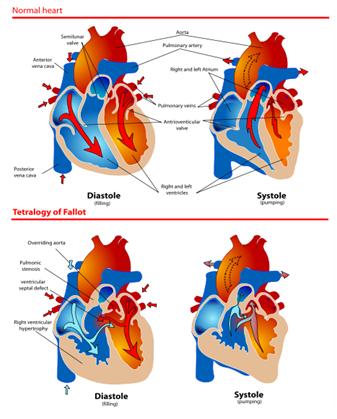Tetralogy of Fallot

Tetralogy of Fallot (TOF) is one of the congenital heart disorders. It is characterized by four inborn abnormalities. It is named after the French physician Étienne-Louis Arthur Fallot. It is the most common cyanotic heart defect, and the most common cause of blue baby syndrome. The four abnormalities are:
- right ventricular outflow tract obstruction (infundibular stenosis),
- ventricular septal defect,
- aorta dextroposition,
- right ventricular hypertrophy (due to infundibular stenosis).
In a very few cases an atrial septal defect can be present, which makes up the pentad of Fallot. Venous return is normal to the right heart. The pressure of blood in right ventricle is higher because of the stenosis. That is why the deoxygenated blood flow throw ventricular septal defect to left ventricle and aorta where it is mixed with oxygenated blood from left ventricle. Therefor bloodoxygen saturation is low and the sick child is cyanotic. Other symptoms are heart murmur, difficulty in feeding, retarded growth and psychical development, dyspnoa, clubbing fingers.
Diagnosis - echocardiography takes first place in diagnosis. Other helpful methods are: ECG, angiography.
Threatment:
Tetralogy of Fallot is always an indication for open heart surgery. Farmacotherapy is used to rise blood oxygen saturation: beta-blockers help in acute hypoximia and prostaglandin E dilates ductus arteriosus Botalli.